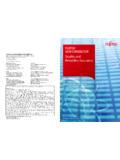Transcription of Financial Flows & Supply Chain Effi ciency - Visa
1 Financial Flows & Supply Chain Effi ciencyExecutive Summary By Professor Warren H. HausmanDepartment of Management Science & Engineering, Stanford UniversitySponsored by Visa Commercial SolutionsINTRODUCTION1 SUMMARY 2 OVERVIEW 3 Supply Chain Flows Financial Flows in the Supply Chain Supply Chain & Financial FLOW CHALLENGES 5 Supply Chain Management Challenges Financial Flow Management Challenges Supply Chain & Financial FLOW TRENDS & BEST PRACTICES 7 What s Happening in Supply Chain Management What s Happening in Financial Flow Management KEY PERFORMANCE INDICATORS FOR Supply CHAINS & Financial Flows 9 KPIs for Supply ChainsKPIs for Financial Flows How Supply Chain and Financial Flow KPIs Connect for Greater Efficiencies IMPROVEMENT OPPORTUNITIES FOR Financial Flows 11 ConclusionsKey Questions for ManagementAction itemsTable of Contents1 | Financial Flows & Supply Chain Effi ciencyVisa International Commercial Solutions.
2 As a payment industry leader, is focused on identifying opportunities for organizations to reduce management expenses and optimize benefi ts from their back-offi ce economic conditions are forcing companies to improve expense management practices. As a result, a growing number of fi rms are seeking innovations to increase effi ciencies for all areas of their International commissioned Warren Hausman, a Supply Chain management expert and Professor in the Department of Management Science & Engineering, at Stanford University, to identify, analyze and communicate the impact that a corporation s fi nancial fl ows have on overall Supply Chain effi part of this effort, several multinational companies across multiple industries within Latin America were interviewed to identify: How leading companies are currently managing fi nancial fl ows and how they can achieve more savings with the implementation of advanced payment information management systems Activities that constitute best-in-class payment systems and Supply Chain management automation to obtain greater savings levels How tying together Supply Chain and fi nancial fl ow key performance indicators brings greater effi ciencyWe hope you fi nd this report useful in understanding how your company can use advanced payment solutions to reap optimal fi nancial fl ow and Supply Chain management benefi ts.
3 We are confi dent that the fi ndings will help your organization make prescriptive changes that result in quantifi able bottom-line de la VegaVice PresidentCommercial SolutionsVisa Latin Americaand the CaribbeanAliza KnoxSenior Vice PresidentCommercial SolutionsVisa InternationalSummaryKey Findings Financial fl ows in Supply chains have not kept pace with Supply Chain management improvements. New innovative payment solutions are poised to make major improvements, making fi nancial fl ows faster, more reliable, more predictable, and less costly. Despite the fact that companies have made a large number of signifi cant Supply Chain management improvements over the past decade, there are still some unique Supply Chain management challenges affecting operational effi ciencies and service. On the fi nancial fl ow management side of the Supply Chain , there are several challenges that when viewed collectively require higher Working Capital than necessary.
4 If, however, these challenges were removed, the money saved could be shifted to more valuable uses. Today, more and more visionary companies are adopting innovative technologies and payment solutions that enable greater, faster, and more cost effi cient Supply chains. The latest trends and best practices in Supply Chain and fi nancial fl ow manage-ment particularly in the area of automated pay-ment solutions have demonstrated tremendous strides in improved Supply Chain performance. Using industry-wide Supply Chain metrics, it can be shown that Key Performance Indicators (KPIs) for fi nancial fl ow management have a correlation to product Supply Chain performance, and can directly impact metrics such as fi ll rate, product availability on the shelf, on-time delivery, inventory value, the inventory-service trade off curve, and the cash-to-cash cycle. Adopting new automation solutions to fi nancial fl ows such as Purchasing Cards (P-Cards), Distri-bution Cards, and Electronic Invoice Presentment and Payment (EIPP) systems creates signifi cant improvement opportunities in many areas including higher speed, cost savings, lower Days Sales Out-standing (DSO), and more reliable and predictable fi nancial fl opportunities and challenges lie ahead in managing fi nancial fl ows in Supply chains.
5 In the past thirty years tremendous strides have been made regarding Supply Chain effi ciencies sharply reduced lead times, lower inventories, more responsiveness, increased variety, more collaboration on planning and forecasting, and improved customer service. In most respects, fi nancial fl ows are still performing as they did in the 1970 s with signifi cant delays in processing and reconciling invoices, long Days Sales Outstanding (DSO) for accounts receivable (A/R), and signifi cant funds held in Working Capital to deal with uncertainties in infl ows and outfl the fi nancial Supply Chain is in a critical phase of evolution. New automation solutions show high potential for reducing processing costs signifi cantly. They also offer enhanced visibility, which means less uncertainty in accounts receivable (A/R) and accounts payable (A/P), hence a signifi -cant reduction in Working Capital needs.
6 Furthermore, they also accelerate the process of procur-ing goods, which in turn, accelerates payment and invoice reconciliation, and they reduce Visa Commercial Solutions Industry Briefi ng offers a closer look at invoice, payment, and information fl ows in today s Supply Chain . The Industry Briefi ng presents the many opportunities that exist for improving fi nancial fl ows, as well as an analysis of their impact on fi nancial fl ow Key Performance Indicators (KPIs).SummaryFinancial Flows & Supply Chain Effi ciency | 23 | Financial Flows & Supply Chain Effi ciencyGreat opportunities and challenges lie ahead in managing fi nancial fl ows in Supply chains. In the past thirty years, tremendous strides have been made regarding Supply Chain effi ciencies sharply reduced lead times, lower inventories, more responsiveness, increased variety, more collaboration on planning and forecasting, and improved customer service.
7 But in most respects, fi nancial fl ows are still performing as they did in the 1970 s with signifi cant delays in processing and reconciling invoices, long Days Sales Outstanding (DSO) for accounts receivable (A/R), and signifi cant funds held in Working Capital to deal with uncertainties in infl ows and outfl : Material, Information & FinancialUpstream: Material, Information & FinancialFlows in Supply ChainsCHART Pg 2 Flows in the Supply ChainsAs the adoption of new automation solutions for fi nancial fl ows becomes more widespread, the Superior effi ciencies gained from electronic payment technolo-gies are becoming more measurable and Chain FlowsA Supply Chain is a network of partners that produces raw materials, subassemblies, and fi nished products, then distributes them via various sales channels to customers. Along this Chain , there are three major fl ows: material, information, and fi Flows in the Supply ChainInvoices and PaymentsThe fi nancial fl ow in a typical Supply Chain includes thousands of invoices and payments in a given year.
8 The scale of this problem is challenging corporations to fi nd ways of streamlining their processing. There are also considerable savings to be obtained in other categories besides processing single organization in the Supply Chain has both Accounts Payable (A/P) and Accounts Receivable (A/R) activities. Each invoice is an A/P from the downstream buyer s perspective and an A/R from the upstream seller s viewpoint. Multiple invoices, however, are often paid by a single payment. This requires information as to which specifi c invoices are covered by a remittance. Also, when invoices are reconciled prior to payment, the three-way match of purchase order ( ), shipping receipt, and invoice may fail if all documents are not precisely consistent. Both of these potential failures can often be dealt with by innovative payment solutions with pre-established tolerances for automated TransferFinancial fl ows also include information transfer via Electronic Invoice Presentment (EIP) and electronic payments.
9 This combination constitutes the Electronic Invoice Presentment and Payment (EIPP), an advanced payment application that automates specifi c fi nancial tasks, as well as provides the opportunity to collect, aggregate, and share valuable information across the Supply recently, information and fi nancial fl ows were treated separately. However, innovative payment 1 Andrea Klein, The Financial Services Supply Chain : Integrating That Last Mile , A Supplement to American can now include detailed transaction information such as date and time of receipt, supplier name, quantity received, number, etc. Having both fi nancial and detailed product information available electronically can minimize human errors, reduce reconciliation time, and create a more tightly integrated Supply Chain . Importantly, banks can aid customers in ensuring that reconciliation and posting to General Ledger (GL) is integrated Flows & Supply Chain Effi ciency | 45 | Financial Flows & Supply Chain Effi ciencySupply Chain & Financial Flow ChallengesCHALLENGE: Information DistortionSOLUTION: Ensure rapid information exchange along the chainOne cause of the Bullwhip Effect deals with informa-tion distortion.
10 If consumer sales increase by 5 percent in a given week, a retailer could end up ordering 7 percent more product in response to the increase and a feeling that demand will continue. The next link in the Chain , observing what appears to be a 7 percent increase in demand, then orders a larger increase on his supplier. Eventually the factory may observe an infl ated 20 percent increase in in transmitting changes regarding demand or Supply can amplify problems. A good way to deal with this situation is to share point-of-sales (POS) informa-tion with all partners in the Chain . Emerging electronic payment ( card-based solutions) and information management tools provide a new way of sharing : Vendor-Managed Inventory (VMI)Another way to deal with information distortion involves giving the supplier decision rights regard-ing the timing and quantity of replenishments.



